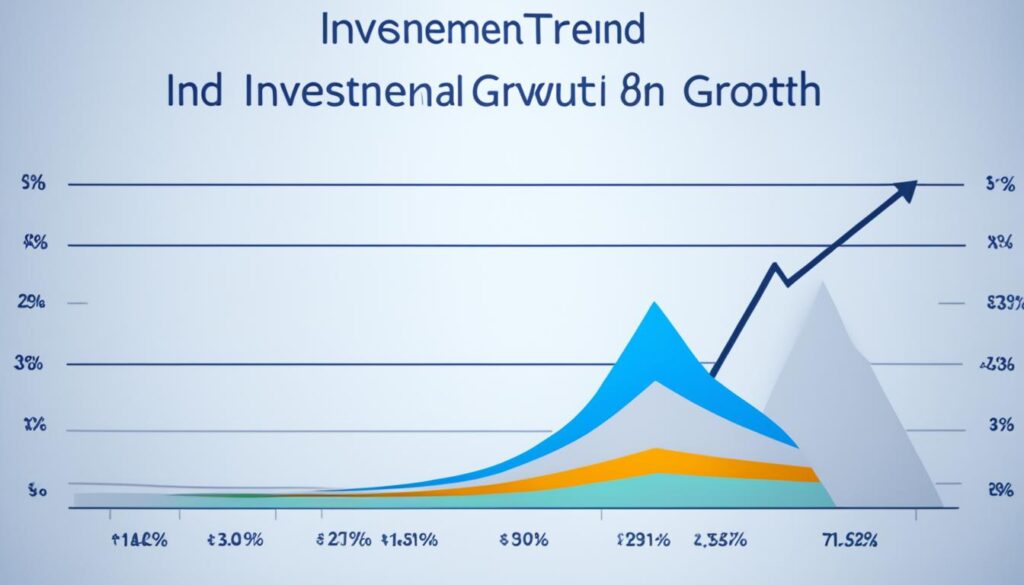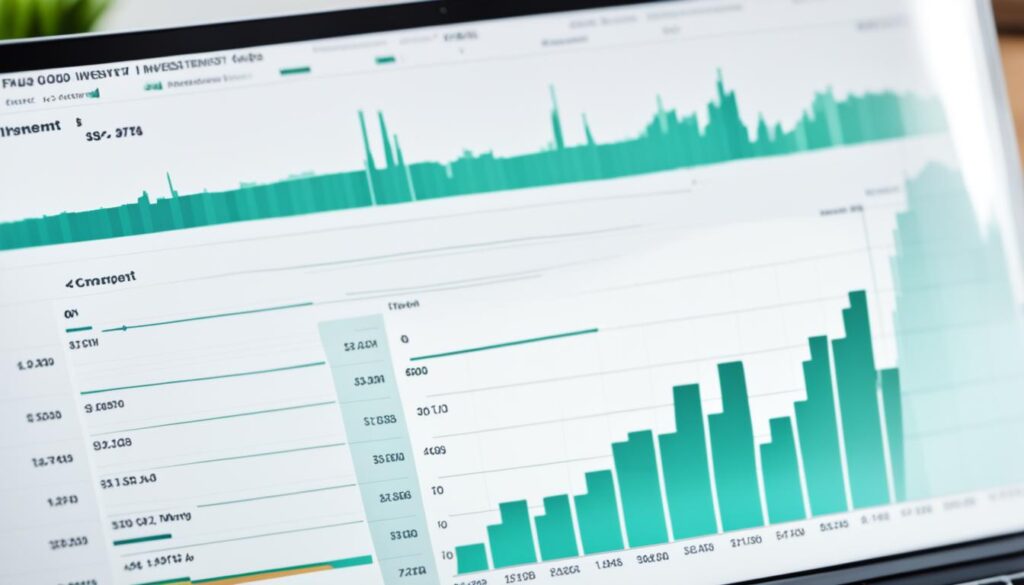Investing can seem tough at first, but it’s key for gaining financial freedom. This guide will teach you how to start investing online. You’ll learn to grow your wealth right from your house.

Key Takeaways:
- Investing is essential for financial independence and wealth building.
- Start investing as early as possible to take advantage of compound earnings.
- Decide on the amount to invest based on your financial situation and goals.
- Open an investment account tailored to your specific needs.
- Pick an investment strategy aligned with your goals and risk tolerance.
Start Investing as Early as Possible
Starting early is crucial for building long-term wealth. Investing young lets you use compound earnings fully. This boosts your returns over time.
Compound earnings are when returns from investments make more money. By putting these earnings back in, your money can grow a lot. Starting early makes this growth stronger, letting your funds increase more.
You don’t need lots of money to start investing. Many platforms let you start with just a few dollars. With no fees and options like fractional shares, it’s easy to spread out your money and explore different investments.
Beginners like index funds, ETFs, and mutual funds. These funds combine many people’s money to invest in various things. They’re managed by experts, making it easy and affordable to start investing and growing your wealth.
To show how good early investing is, look at this example:
| Investor | Starting Age | Investment Amount | Return on Investment | Total Investment Value at Age 65 |
|---|---|---|---|---|
| John | 25 | $1,000 | 7% annually | $21,725 |
| Emily | 35 | $1,000 | 7% annually | $10,063 |
| David | 45 | $1,000 | 7% annually | $4,891 |
This table shows how early investing makes a big difference. John started young and ended with much more money at 65. This is because his money had more time to grow.
It’s best to start investing as soon as you can. The sooner you begin, the more your money can grow thanks to compound earnings. Long-term growth is a huge benefit of starting early.
Decide How Much to Invest
Investing amounts depend on your financial situation and goals. It’s key to assess your circumstances closely and choose your investment amount wisely.
You should aim for saving 10% to 15% of your yearly income for retirement. This lets you grow a retirement fund while managing other money needs.
For aims like buying a home or funding school, look at your time frame. Then, break the needed amount into smaller, monthly or weekly parts. By doing this, you make reaching your goal possible through a clear plan and a realistic time frame.
“Investing isn’t just about the amount of money at hand; it’s how you use what you’ve got. Knowing your finances and goals lets you choose wisely.”
– John Smith, Financial Advisor
Evaluating your financial state lets you find the right investment amount for your goals. Finding a balance is crucial. It helps you progress and keep financial stability now.
Investment Amount Calculation Example
Imagine you want to buy a house in five years, and need $50,000 for a down payment. Knowing your deadline and the needed amount, you can figure out how much to save monthly:
| Time Horizon | Required Amount | Monthly Investment |
|---|---|---|
| 5 years | $50,000 | $833 |
In this scenario, saving around $833 each month for five years gets you to your goal. Breaking goals into smaller monthly savings makes them easier to achieve.
Everyone’s finances and goals are different. It’s important to understand your case, maybe get advice from pros, and choose investments that fit your goals and how much risk you can take.

Open an Investment Account
Choosing the right investment account is crucial for meeting your financial goals. If you’re saving for retirement or after short-term gains, there are many accounts to look at.
An individual retirement account (IRA) or a 401(k) are great for retirement savings. These options offer tax benefits and let your money grow until retirement. By putting a part of your income into an IRA or 401(k), you could see bigger returns than with regular savings.
If you’re not focused on retirement, a taxable brokerage account might be better. You can take money out anytime without penalties, unlike retirement accounts. This account type lets you invest in various assets like stocks and ETFs, helping diversify your investments and possibly increasing returns.
Picking the right account means looking at your goals and how long you’ll invest. Do your homework and talk to a financial advisor to find what’s best for your long-term financial plans.

Choosing the Right Investment Account
Think about these factors when selecting an investment account:
- Your investment goals: Are you saving for retirement or other financial milestones?
- Your time horizon: How long do you plan to keep your investments before needing to access the funds?
- Your risk tolerance: Are you comfortable with potentially higher levels of risk in pursuit of potentially higher returns?
- Your tax situation: Do you prefer tax-advantaged accounts like IRAs or taxable brokerage accounts?
Take time to understand these aspects and your own financial situation. This way, you can choose an account that fits your needs, whether it’s for more freedom or for growing your money over time.
Pick an Investment Strategy
Building wealth and achieving your financial goals depends on the right investment strategy. Your strategy should match your saving goals, time frame, and how much risk you can take. Knowing these factors lets you make choices that grow your wealth.
For long-term goals, like retirement, focus on investments that can grow a lot. The stock market is a top choice for long-term investing. Investing in stocks through mutual funds, index funds, or ETFs lets you benefit from overall market growth.
Over time, stocks have given higher returns than other options. They are more volatile and risky, yet they offer great potential rewards for those investing for the long term. But remember, investing in individual stocks is risky and needs careful research.
If you’re saving for the short term, consider a safer approach. Bonds and cash management accounts provide stability and security. Bonds are safer than stocks and offer income through interest payments.
Robo-advisors have also become popular. These automated platforms create and manage portfolios based on your goals and risk level. They’re a handy and low-cost way to invest in a mix of stocks, bonds, and other assets.
There’s no universal strategy that works for everyone. It’s vital to consider your goals, timeframe, and risk tolerance to find what works best for you. A financial advisor can help tailor recommendations to fit your needs.
Benefits of a Well-Defined Investment Strategy
A clear investment strategy has several advantages:
- Clarity: It helps you stay focused and avoid snap decisions that could hurt your returns.
- Consistency: Sticking to your strategy lets you benefit from market trends without trying to time the market.
- Diversification: A good strategy diversifies your portfolio across different areas, minimizing the impact of any single investment.
- Optimized Risk-Return Trade-Off: It helps you balance the potential returns with a risk level you’re comfortable with.
Investing is about the long haul. Being patient and disciplined is key to reaching your goals and building wealth that lasts.

Understand Your Investment Options
It’s key to know the different investments you can make. Each has its own features and benefits. This lets you match your investments to your goals, how much risk you’re okay with, and when you need your money back. Let’s look at some common ways to invest:
1. Stocks

Investing in stocks means you own part of a company. As a shareholder, you get a share of the company’s profits and assets. Stocks can bring high returns but they’re riskier. It’s important to choose stocks wisely or think about putting your money in diverse stock portfolios like mutual funds and ETFs.
2. Bonds
Bonds are like giving a loan to companies or governments. You lend them money, and they pay you back with interest. At the end of the bond’s term, you get your initial money back. Bonds are usually safer than stocks, so many people looking for steady income choose them. They make your investment mix more stable and give you predictable returns.
3. Mutual Funds
Mutual funds collect money from lots of investors to buy a bunch of different assets. Professional managers pick where to invest this pooled money. Through mutual funds, your investment is spread out to cut down risk. They’re great for people who don’t want to manage their own investments.
4. ETFs
Exchange-Traded Funds (ETFs) are like mutual funds but you can buy and sell them on stock exchanges. ETFs let you invest in various assets easily, flexibly, and with the ability to sell quickly. They aim to follow certain indexes or investment strategies. ETFs are a smart way to get into different markets without the hassle of picking each investment yourself.
Understanding your investment options well is vital. Think about your financial goals, how much risk you can handle, and your investment timeline before deciding. Spreading your investments and regularly checking your portfolio can help you meet your financial goals.
| Investment Option | Risk Level | Return Potential |
|---|---|---|
| Stocks | High | High |
| Bonds | Low to Moderate | Low to Moderate |
| Mutual Funds | Varies based on underlying investments | Varies based on underlying investments |
| ETFs | Varies based on underlying investments | Varies based on underlying investments |
Table: Comparison of Investment Options in terms of Risk Level and Return Potential
Make a Plan for Building Wealth
Building wealth needs a well-thought-out plan. This includes a financial plan, budgeting, having an emergency fund, setting up automate finances, and managing debt. Adding these key parts to your financial plan prepares you for long-term success.
Creating a Budget
Creating a budget is key to building wealth. It helps you keep track of spending and set aside money for investments. Start by noting your income and sorting your expenses.
This gives you a clear view of your finances. It also shows where you can save more. A good budget helps you focus on your financial goals and keep on track.
Building an Emergency Fund
An emergency fund is crucial to any financial plan. It’s your backup for unexpected costs or emergencies. Try to save three to six months of living expenses in a special savings account.
This backup keeps you from using credit cards or incurring high-interest debt during hard times.
Automating Finances
Automate your finances to effortlessly save and invest. Set automatic transfers to your savings and investment accounts. This way, you won’t forget to save or lose a chance to invest.
It also stops you from spending money that should go towards your wealth.
Managing Debt
Good debt management is vital for wealth building. High-interest debt can slow your progress by limiting savings and investment potential. Craft a plan to clear debts and stay away from new debts.
Pay off high-interest debts first while keeping up with other payments. This method reduces interest costs and speeds up your wealth building.

| Benefits of a Financial Plan | Budgeting Tips |
|---|---|
|
|
Maximize Retirement Savings
Securing your financial future is vital. Retirement savings are key to this goal. This guide will help you make the most of your retirement savings for a comfortable future.
Retirement Savings Options: 401(k) and IRAs
Employer-sponsored 401(k) accounts and individual retirement accounts (IRAs) are great for retirement saving. They offer tax benefits and various investment options to grow your savings.
With a 401(k), your pre-tax income contribution lowers your taxable income. Many employers also match a part of what you contribute. This match is like free money, boosting your savings.
IRAs are another option for saving. Traditional IRAs use pre-tax dollars. Roth IRAs work with after-tax money. Both offer tax advantages, making your investments grow tax-free till retirement.
Navigate Contribution Limits
Understanding contribution limits set by the IRS is crucial. Going over these limits can lead to penalties. For 2021, the 401(k) contribution limit is $19,500 for those under 50. People 50 and older can add another $6,500 each year.
The 2021 contribution limit for IRAs is $6,000 for those under 50. If you’re 50 or older, you can contribute an extra $1,000. Note that these limits may change, so always check for updates.
The Power of Compound Earnings
Regular contributions and compound earnings can greatly increase your retirement savings. Compound earnings mean your investment’s growth will generate more returns. This effect can boost your savings significantly.
Let’s look at an example:
| Investment Amount | Annual Contribution | Years Invested | Annual Return | Total Savings |
|---|---|---|---|---|
| $5,000 | $500 | 20 | 8% | $225,792 |
| $10,000 | $1,000 | 20 | 8% | $451,584 |
| $20,000 | $2,000 | 20 | 8% | $903,169 |
Here, annual contributions of $500, $1,000, and $2,000, at an 8% return, lead to big savings. This shows how vital regular contributions and compound earnings are.
To maximize your retirement savings, use a strategic approach. Take advantage of savings options, understand contribution limits, and use compound earnings. Start planning and investing now for a better tomorrow.

Stay Diversified
Diversification in investing helps manage risk and improve returns. By having different assets in your portfolio, you lower the risk of one investment. This strategy builds a strong, balanced portfolio for growth.
Invest in different types of assets like stocks, bonds, and ETFs. This spreads your investments and reduces volatility. It protects your wealth from risks linked to one type of investment.
Diversification can make your investment returns more stable. If one part of your portfolio is down, another might do well. This balances out losses and keeps your portfolio stable through market ups and downs.
Another plus is exposure to various market sectors. Investing in diverse assets lets you grow with different sectors. This strategy lowers the risk of losing a lot from one industry downturn.
Diversification also means managing risks better. If one investment does poorly, others might do well. This spreads out your risk, making big losses less likely.
But remember, diversification doesn’t get rid of all risk. Market changes and investment performance can affect your portfolio. Regularly checking and adjusting your investments helps keep your goals and risk level in check.
Reducing Investment Risks through Diversification
1. Market Risk: Spreading your investments in different asset classes can lessen the blow of market drops. Including uncorrelated assets reduces risks from any one asset or market.
2. Industry Risk: Investing in various industries lowers the risk of big losses from one industry’s troubles. This makes one industry’s poor performance impact your portfolio less.
3. Company-specific Risk: Diversifying across companies within industries reduces risk from one company doing badly. By choosing multiple solid companies, you spread risk.
4. Asset Class Risk: Investing in different asset types, like stocks and bonds, protects your portfolio from risks of one asset class.
5. Geographic Risk: Investing around the world lowers risk from one country’s economic or political issues. Diversification globally offers different growth chances and spreads risk.
Diversification is key to balancing your investments with your goals and risk tolerance. A well-diversified portfolio offers long-term stability and improved returns.
Need more guidance on diversification and risk management? Talk to a financial advisor for advice tailored to your financial situation and goals.
| Benefits of Portfolio Diversification | Key Risk Factors to Consider |
|---|---|
|
|

Build an Emergency Fund
Creating an emergency fund is crucial for your financial safety and peace of mind. Life always has surprises, and extra costs can pop up. A special savings account helps handle these without falling into debt.
Save a bit of your income regularly to grow this fund. First, pick a savings goal that makes sense for you. Aim for three to six months of expenses for a solid safety net.
An emergency fund offers protection and a feeling of stability. It’s there for sudden costs like car fix-ups, health bills, or losing your job. With it, you stay financially secure.
“Having an emergency fund is like having a safety net. It gives you the peace of mind to navigate through life’s uncertainties without worrying about your financial stability.”
Make saving easier by automating it. Set up transfers to your emergency fund from your paycheck or bank account. This keeps your savings on track.
Use your emergency fund only for real emergencies. Keep it for urgent needs. If you dip into it, plan to refill it quickly to keep its value.
Keep in mind, building an emergency fund takes time. As life changes, adjust your savings goals. Adding to your fund regularly keeps you ready for surprises.
Advantages of Building an Emergency Fund:
- Financial security and peace of mind
- Protection against unexpected expenses
- Reduced reliance on credit cards and debt
- Flexibility to handle emergencies without disrupting your financial goals
Disadvantages of Not Having an Emergency Fund:
- Financial vulnerability
- Potential for incurring high-interest debt
- Increased stress during emergencies
- Delayed progress towards long-term financial goals
Increase Your Income
Building wealth isn’t only about investing. It also means finding ways to grow your income. Look for chances to move up in your career or ask for a raise. This helps you earn more and reach your financial dreams. Aim to improve your abilities, tackle new tasks, and aim for higher positions in your job or field.
Think beyond regular career growth. Try out side hustles or passive income ways. Side jobs can help you make extra cash outside your main work. This could be freelancing, creating a business, or using a skill to make money. Meanwhile, passive income lets you earn without constant effort. It can come from renting out property or getting dividends from stocks.
Growing your income brings more stability and chances to save and invest. By having different ways to make money and increasing what you earn, you better your financial health. It speeds up your journey to building wealth. Always aim to learn more and adapt. This helps you stay competitive and grab new opportunities that come your way.